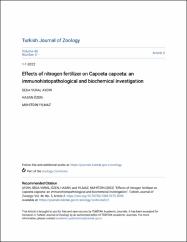Effects of nitrogen fertilizer on Capoeta capoeta: an immunohistopathological and biochemical investigation

Göster/
Erişim
info:eu-repo/semantics/openAccesshttp://creativecommons.org/licenses/by/3.0/us/Tarih
2022Üst veri
Tüm öğe kaydını gösterÖzet
Increased use of fertilizers to increase plant production causes important environmental pollution not only in soil but also in water resources. Soil structure, water quality, water systems, and biodiversity are adversely affected by the unconscious use of fertilizers. In this study, Capoeta capoeta (Guldenstaedt 1773) were used to investigate the degenerative effects of nitrogen fertilizer. Twenty-four fish were equally allocated into three groups; group 1 (control), group 2 (15 mg/L nitrogen fertilizer in water) and group 3 (15 mg/L nitrogen fertilizer in water). Fish were exposed to the fertilizer for 15 days and then the tissues of gill, liver and intestine were investigated by immunohistopathological and biochemical means to assess the tissue degenerative effects of nitrogen fertilizers in water. Varying degrees of degenerative changes were observed in all of the investigated organs. In histopathological examinations, hydropic degeneration was observed in hepatocytes in fish exposed to fertilizer. Blunting and association in the gill tissue and occasional blunting in the intestinal tissue were detected. Catalase and SOD immunoreactivities increased in liver and gill tissues. There was also an increase in SOD immunoreactivity in the intestine of nitrogen fertilizer exposed fish. Total antioxidant status (TAS) also increased in both of the experimental groups (p < 0.05), but total oxidant status (TOS) did not change. The results of the experiment showed that nitrogen fertilizer in water resources may impair health status of fish by adversely affecting tissues in cellular level.
Kaynak
Turkish Journal of ZoologyCilt
46Sayı
5Koleksiyonlar
Aşağıdaki lisans dosyası bu öğe ile ilişkilidir:


















